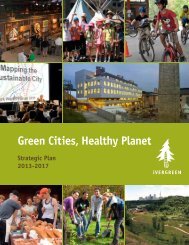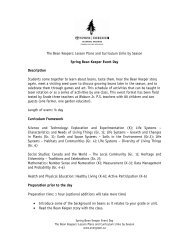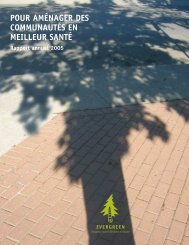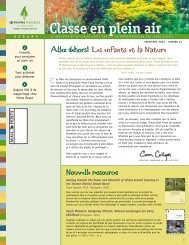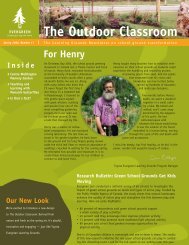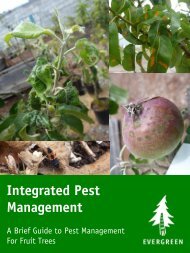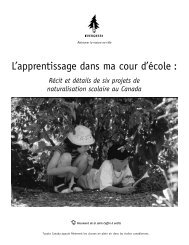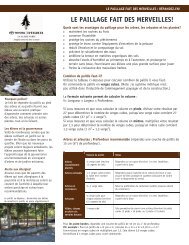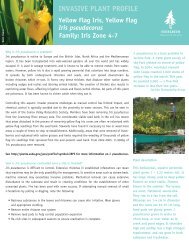View Printable (PDF) version - Evergreen
View Printable (PDF) version - Evergreen
View Printable (PDF) version - Evergreen
You also want an ePaper? Increase the reach of your titles
YUMPU automatically turns print PDFs into web optimized ePapers that Google loves.
A Hands-on ManualAn innovative way to engage students in green building techniques
IntroductionIn August 2007, <strong>Evergreen</strong> partnered with Banyan Tree, a grassroots organization with a mission toeducate youth on building sustainable communities. Together, we designed and raised funds for a pilotprogram that engaged Grade 8 students from Winchester Junior & Senior Public School in St. JamesTown, an inner-city Toronto neighbourhood, in a natural-building workshop: making rammed earth bricksand building a flower bed.Based on a flexible curriculum plan, a backgrounder on Rammed Earth (Appendix A) and a map to thesite (Appendix B), youth were invited to register for the course that would run over two consecutiveweekends. Beginning with a nature hike to <strong>Evergreen</strong> Brick Works at the heart of Toronto’s ravine system,eight committed students learned the history of rammed earth construction, its uses as a buildingtechnique, how to design their own project, how to make bricks themselves and finally how to buildthe structure they envisioned.The plan also provided an opportunity to hand over the project coordination reins to five 20-something,aspiring environmental educators. These resourceful and committed volunteers went far beyond the callof duty, investing months of preparation and planning time, making sure this educational workshop wasfun for all involved.The result was a messy, engaging workshop that entertained and inspired a terrific group of kids tore-evaluate what they were capable of and what is possible in their community. All participants agreethat it was a tremendous success, as reflected in the picture gallery and evaluation results.Designed for optimum replicability and accessibility, with low costs and minimal skill requirements,it also served as a useful case study for incorporating a versatile building technique into future schoolground and other community greening projects across Canada. Funded by The J.W. McConnell FamilyFoundation’s Green Street program, the initiative met their Benchmarks for Excellence in EnvironmentalLearning & Sustainability and Student Engagement, which were designed to initiate programmingthat actively engages youth in environmental stewardship. We are grateful to the foundation for itsgenerous support.2
What is Rammed Earth?Rammed earth is a soil mix (made from varying amounts of locally available and renewable materialssuch as gravel, clay, sand and silt) to which water is added. The resulting moist, soil-based mix isloaded into a mould or press and compacted by ramming or with a manual hydraulic press. Once driedover a period of a couple of days (there is no need for firing bricks), the bricks have similar structuralintegrity and durability levels to normal bricks, without the energy use.Although still largely unknown in North America, rammed earth and similar constructions are among theoldest and most durable forms of construction. No one knows for sure where it originated; all that isknown is that it was used in ancient times by numerous cultures from African to Europe. Even parts ofthe Great Wall of China were built using rammed earth.Today over half of the global population is estimated to live or work in earth-based shelters. 1Natural building techniques like rammed earth use renewable, recycled and/or salvaged resources tocreate structures that are more environmentally friendly than those constructed through traditionalbuilding practices, using materials such as wood, steel, and concrete. “Conventional” building materialsgenerally require a lot of energy (such as fossil fuels) and natural resources to be produced, transportedand, eventually, installed.Rammed earth does have limitations as a building material in the Canadian context. One of the majorlimitations is its susceptibility to water damage. Rammed earth walls do not do well if they are improperlyexposed in a wet environment. When exposed to water, erosion of the wall begins, causing the surfacelayer of the wall to start losing its adhesive bond. Water can also penetrate the wall and when the outsidetemperature gets cold, the expansion of the water will cause the wall to crack. That’s why, throughouthistory, earth structures have not been common in areas where flooding is likely. Earth construction canwork in rainy climates, as long as a stabilizer is added, it is properly covered with a roof and built on afoundation of “cooked” bricks or rocks, preventing exposure to moisture at the base.Due to the impermanent nature of earth construction, it is ideal for formal school grounds because itcan be easily changed or replaced according to need or circumstances. Conversely, left alone, it willnaturally erode over several years, offering lessons in the transitory, evolutionary aspects of nature.However, when treated with a clear non-toxic natural water-based sealant, the structure will last longerand require less maintenance (visit www.greenbuildingsupply.com for more information).What are the Environmental Benefits of Rammed Earth?Earth-based construction offers many advantages over common construction methods practiced today.It is cleaner, less wasteful of water and forest resources and is by definition easily reused.One of the first and most obvious benefits is that the structure is made from soil, a naturally occurringand locally available material that is affordable and easy to work with. Structures can generally be builtwithout heavy equipment, or much fuel or electricity, extending the environmental benefits of this lowimpact construction process.41Source: Earth Architecture
Of course, when building a structure, one of the first steps is to dig out a foundation (or hole) to createa level base. With standard practices, this dug-out soil is not used in the construction of the buildingand is typically either trucked away or spread out around the property. With rammed earth construction,this soil will instead be used as the primary building material.Another crucial advantage of earth construction (in particular, rammed earth) is the low cement contentin the mixture. Concrete is the world’s most widely used building material and is made up of 10-25%cement by volume. The problem is that cement is one of the most energy-intensive products tomanufacture, requiring large quantities of fuel and heat. As a result, it is one of the largest singlecontributors to greenhouse gas emissions and accounts for 7-8% of the world’s carbon dioxide emissions.Because rammed earth construction has minimal cement content, typically less than a quarter of theamount found in concrete mixtures, its use would lead to significantly reduced greenhouse gas emissions,limiting a key contributor to global warming.A key component of most modern construction techniques is finished wood, leading to significant forestdepletion. Indeed wood building materials account for 25% of the world’s wood consumption. Sincerammed earth construction does not use wood resources it does not contribute to forest depletion.In addition, rammed earth construction uses very little water to create and facilitate the bondingand compaction of the earth. On the flip side, concrete, steel and plastic are major consumers of thisvaluable and increasingly precious resource in their production stages.Finally, rammed earth walls are made from renewable materials that can be very simply reused when thebuilding is no longer wanted or needed.What are the Health Benefits of Rammed Earth?Rammed earth walls are made from soil that is extracted deep enough in the ground to avoid theinclusion of any organic materials. Without organic materials like leaves and seeds, there is no foodin the mixture and therefore no danger of attracting animals, insects or mold growth.Particularly important to occupant health is the presence of clay within the mixture. Clay is a hydroscopicmaterial, meaning that it has the ability to absorb and release moisture in the air. This is particularlyuseful to regulate the amount of humidity, which not only affects our comfort level within a structure,but also limits fungus and mold growth that could otherwise leads to respiratory problems. An eightyearstudy in Germany demonstrated that earth walls are effective at regulating internal relative humidityat between 40% and 60% all year round, regardless of the outdoor humidity levels.Remarkably, the dense and compacted material also acts like a storage container for heat. When the sunstrikes the wall, the energy from the sun is stored in the wall for hours, eventually finding its way intothe structure. The walls act like a temperature regulator or thermal mass: when it is hottest outsideand the sun is at its most intense, the energy is stored in the walls until it is released when the ambienttemperature is colder.5
The ConceptBricks of the Earth is designed to give youth a creative outlet, a new skill and the tools to initiatea similar project in their community or school. The ultimate goal is to encourage youth to experimentwith a new material in an active hands-on way, while learning valuable lessons about sustainabilityand global environmental issues.First presented in September 2007 by <strong>Evergreen</strong> and Banyan Tree Initiatives, the Bricks of the Earthworkshop focused on sustainable design and construction. Bringing together youth from St. Jamestown,an at-risk neighbourhood in Toronto, the group built a raised garden bed over the course of two weekendsand learned a great deal about green building techniques. The workshop enabled youth to interact witha multi-disciplinary team of volunteers and professionals from fields that were new to them.Project RationaleIssues around sustainable urban development and environmental construction are for all intents andpurposes completely absent in both the school curriculum and existing community initiatives aimedat youth growing up in Toronto. This project was designed to address this. Furthermore, because theproject was carried out at <strong>Evergreen</strong> Brick Works, it allowed for broader discussion of the site’s geological,cultural and environmental contexts and the broader role nature plays in community and city building.For instance, as the site is prone to periodic flooding, rammed earth was suitable as an organic, nondisruptiveproject that could highlight significant issues and yet be inexpensive to repair or replace.In addition, facilitators were able to reinforce the values of teamwork, inclusiveness, careful listening,environmental awareness and action. This workshop provided a rare and much-needed opportunity forthese young people to reveal undiscovered talents and skills in a safe and supportive learning environment.Different Ways You Can Use the Bricks of the Earth ConceptRammed earth bricks can be used in a wide variety of projects. The various projects listed here canbe initiated and undertaken by students, teachers and community leaders or volunteers. Engagingindividuals experienced with earth-based building may be desirable depending on the scope of theproject and the skill level of the participants.Raised garden bedsBuilding a raised garden bed out of rammed earth allows for an organic shape that acts as a retainingwall for an herb and vegetable garden. This was the project used for the pilot workshop of Bricks ofthe Earth. That being said, rammed earth construction is not considered an ideal building material forexposed garden beds, but for the limited timeframe of this workshop, it was considered acceptable.WalkwaysBring a team of youth together to build a series of natural brick walkways—discovery paths, perhaps.These will slowly go back into the ground over time, creating opportunities for learning aboutsustainability and natural processes such as erosion, while encouraging ongoing experimentationand community project.6
Storage shedFor the more ambitious groups, creating a storage shed could be an invaluable component to a communityor school garden. It is recommended that the foundation bricks contain some concrete for durability.Another option is to incorporate light wood framing.Sitting areasMore manageable than a shed, a bench can be a quick and fun activity. The design could integrateexisting materials such as logs, wood beams or recycled steel.Art and sculptureTrue art has no boundaries... allow your participants to use their imagination and create wonderfullong-lasting sculptures made from rammed earth.Other ideasThere are plenty of other ideas for more ambitious projects which would require input from leaders withsome experience with these materials.
Project Planning and DesignChoosing the Right IngredientsIt is critical that the ingredients within the soil be suitable for this type of construction and that theybe well mixed and blended together in a specific ratio of gravel, sand, clay and silt. Each material playsan important role. To produce a strong and durable wall or brick, the soil must be a well-graded blendof different-sized particles. Large particles provide the bulk and strength of the mixture, while smallerparticles fill the gaps, creating a crucial bond. When the soil is compacted, these small particles will fillall the empty air space, improving the strength and durability of the wall.Clay is an ideal small particle within the mixture. Because clay is sticky when wet but hard when dry,it acts like a glue using water to bond big particles with smaller ones. Interestingly, clay particles areelectrically charged and act like magnets drawing water molecules to the surface. This unique characteristicof clay allows it to hold neighbouring particles together. With too little clay, the components will nothold and the mixture will fall apart. With too much clay, the walls will shrink and crack.Fine silt also plays a crucial role filling in gaps in the brick or wall. When the material is compacted,the silt will fill tiny gaps and in doing so, limit the amount of air and water that can be trapped within.Too little silt content will produce a wall that is somewhat fragile because it is insufficiently dense.Conversely, too much silt in relation to clay content will prevent the mix from achieving the properconsistency for effective drying and setting.Cement is also typically added to the mix to increase the strength of the finished wall and improve theresilience to water and erosion. The amount of cement added varies and depends on the soil properties,but is typically a very small percentage. In some cases, it can be withheld from the mixture altogether,depending on the quality of soils used.By adding water to the blended soil mixture, the bonding between the clay and the other particles isactivated. When the damp soil is compacted, the clay is forced to bond with the other particles in themixture, creating a strong wall. Too much water in the mixture will not allow for proper compaction andwill cause cracks when drying. Too little water will prevent the ingredients from bonding with the clay,and the mix will not hold together.Getting the Right MixThe exact ratio of silt, sand, gravel and clay depends on the specific properties of the ingredients in thesoil in use. You can use the following ranges (by mass) as a guideline:Sand and Gravel 45-80%Silt 10-30%Clay 5-30%Cement 4-8%As a general rule, the strength of the wall is increased by the compaction effort (or resulting density)and is reduced by increasing moisture content and clay content. When heavy compaction of moist soilis combined with cement stabilization, compressive strength and water resistance is significantlyimproved in comparison with traditional adobe blocks.8
Assessing your SiteMaking rammed earth projects can be a lot of fun, but is also a lot of work. To avoid wasting time, it isbest to verify that the soil can be used. This is the first and most important step before beginning anyproject. Will your site support rammed earth blocks? It’s easy to conduct a quick site assessment todetermine if the available soil is suitable for ramming. Here are two simple ways to doit prior to contacting an expert:Method A:Mix a sample of soil (1-2 cups) and with a lot of water in a jar. As the soil settles, various layers ofsilts, organic matter, sand and stones will create unique layers that will help to determine how muchsand and clay is at the site. The approximate ratios should fall within the following range:Sand and Gravel 45-80%Silt 10-30%Clay 5-30%Method BTake a small handful of soil and moisten it so that it feels damp, but not wet. Form it into a firmball. Next, drop the compacted ball on the floor and see how it breaks. If it crumbles, then thereis probably not enough clay. If it only separates into a few larger clumps or remains as a whole,the soil is reasonably good. If its splats, too much water has been mixed into the soil sample sotry again with less moisture.If the results look positive, we recommend that you have an expert to confirm your initial test results.Some recommended sources are as follows:• Local universities and colleges may have a soil lab like the one in George Brown College’sDepartment of Construction Engineering;• Local landscapers may be able to test it themselves or can recommend someone who can9
The ProjectCreating your CommunityIn our experience, Grade 8 students are an ideal age to participate in rammed earth project becausethey have the physical strength to do the work and they have the intellectual curiousity and mentalacuity to be interested in the various issues and themes which emerge, including the differingenvironmental impacts of conventional and natural construction. Projects should not be undertakenwith children younger than sixth graders unless the format is altered to deliver a demonstration-basedproject. This will require more front-end or background work by the project organizers.Friend-raising is often just as important as fundraising if you want your project to be a success. Afterall, this is a complex and challenging undertaking that requires a lot of people with different skillsand experiences. Among the friends you should be looking for are those interested people who havepartnered with a school before, have the time and capacity to help you. and who are active withina larger network or pool of volunteers.Among the many sources for the type of friend or supporter you need, we recommend the following:• Local community centres• Nearby faith-based community and church groups• School councils/parent-teacher associations• Principals and teachers• Environmental and social justice organizations• Local building supply companies (they may offer material for free or at a reduced rate)• Students looking to earn their community hours• Youth groups such as guides or scouts• Service clubsFinancialsThere are going to be costs associated with a project this ambitious so it is best to think of creativeways of raising funds and defraying costs. Partnering with a group such as <strong>Evergreen</strong> or Banyan TreeInitiative can making sourcing all the materials for a project easier and less costly. You may also beable to get access to equipment through in-kind donations from local contractors, landscaping companies,hardware stores or big box stores like Rona or Home Depot. Also, most schools have a lot of the neededequipment on hand through the janitorial department. If money does need to be raised, you will haveto consider a variety of fundraising events, perhaps having solicited local businesses to provide matchingfunds. Successful fundraising plans source diverse streams of revenue. If your project is on a daycare orschool ground, consider applying to Toyota <strong>Evergreen</strong> Learning Grounds Grants for the plantingmaterial http://www.evergreen.ca/en/lg/lg.html10
Determining timelines and milestonesDeveloping a schedule at the start of the project is critical. Be generous when estimating the time theproject will take, especially if this is your first time building with rammed earth. Remember, your schedulewill be affected by weather so choose your start date carefully and consider scheduling rain dates.Conduct a meeting with your core team (3 or more people) and set a couple of major milestones forthe project in a workback format. Here’s an example (working back from point of completion):• Certificates of completion awarded• Site cleaned up• Last brick laid and secured• Bricks stored for curing• Bricks made and stored• Machine arrives at site• Materials and equipment delivered• Materials ordered• Participants confirmed• Students engaged• Teachers engaged• Brochure designed• Budget determined• Planning meeting completed• Initial stakeholders meeting completed• Reading the Bricks of the Earth ToolkitLaying the GroundworkOf course another important part of getting the project off the ground is to ensure you have all thego-aheads, okays and buy-ins you will require. These will include the• School-related approvals• Proper mentor support• Banyan Tree support• <strong>Evergreen</strong> approvalsSetting the AgendaIn order for any project to be a success, you need to ensure that you have planned it all carefully.This must include the setting of effective, realistic and actionable agendas. Here is an example.Sample Workshopping Agenda• Examine the types of construction materials commonly used to build Canadian school grounds• Uncover the rationale behind material selection and the corresponding environmental ramifications• Explore the role school grounds play in learning• Create a sense of shared space through a visioning and sketching exercise• Presentations of before/after sketches. (Perhaps invite a professional to explain possiblesustainable construction materials.)• Explore examples of what is possible on school grounds. The session will conclude with a focuson rammed earth.11
Determining the ScopeOf course, a large part of the launch must focus on the scope and location of the project. Thiswill require a well-attended and organized planning meeting. It is up to the participants themselvesto determine as a group the size, shape and location of a project so that it will work well ontheir chosen site.Another crucial step is determining how many bricks will be needed (bearing in mind that there may bea significant number of pre-made bricks supplied). The session will conclude with preparation activitiessuch as drafting, clarifying role expectations and practicing use of the equipment.Understanding the Brick-Making ProcessYou need to outline the whole process in advance, including describing the various work stations androles that will maintain project momentum and ensure quality control. Have each student work througheach station step-by-step (typically three students together move through each station at a time). Itshould look something like this:Station 1: Mixinga) Materials leader (typically staff leadership): makes sure materials and tools, gloves, etc. are sufficient,readily available and cleanb) Ratio leader: remembers the right amounts of sand, silt and water and knows (by touch) whenthere is a need for more or lessc) Timing leader: makes sure that the supply of mixed material is working in harmony with thespeed at which bricks are being pressed. If there is an over-production of mix, a bottleneck willoccur as there is only one press to mould the material. If the mix is left to air dry for longer than20 minutes (depending on weather conditions), it will no longer be suitable for the press. Effortsto revitalize the mix by adding water are not particularly effective.Station 2: Pressing and Dryinga) Packers: 1-3 students will be needed to move pre-mixed materials from wheelbarrow into thebrick press form.b) Presser: work with the staff leader operating the pressc) Dryer: this person delicately lifts the new brick from the press to the drying station. It is importantthat they handle the brick with wide, distributed support across the sides of the brick with thefull expanse of their hands.Tools and MaterialsMaterials and equipment needed to complete a rammed earth project include:• Brick press or forms (can be made with plywood)• Shovels• Wheelbarrows• Large and small buckets for mixing and water• Gloves• Soil (sand, clay, silt and gravel)• Water• Potentially some cement to strengthen the mix• People... and lots of them!12
Setting a PaceIt generally takes about one hour of trial and error after the initial training session for the kids toget the hang of things and fall into a routine. They will need on-going reminders of proper and safemachinery operation techniques, as well as effective material ratios for the best bricks. After about twohours, brick making will seem a bit tedious and the kids will need a break for water and snacks andthen some time to blow off steam doing something else entirely. You may choose to allot 20 minutesor a full hour for a break (depending on the time of day). It is important to outline how long the breakwill be, and what will be expected on their return, to allow for a better transition back into the brickmakingprocess. This time also proved to be very helpful for the staff leaders to replenish materials andadjust agenda timelines based on their progress.Connecting to the CurriculumThere are a great many ways in which a teacher can connect these activities to academic requirements.For instance, there are many issues surrounding local heritage such as learning what resources wereused to build your city? Where did they come from? How were they developed? Another fertile topic is,as discussed above, climate change,and the need for alternative resource use and attitudes in construction.Science teachers might consider using the project to explore the earth sciences, discussing the naturalprocesses (chemistry, physics, etc.) that are involved in rammed earth building.At the EndAfter all the planning, hard work, fun and learning, organizers should ensure that there is time left fora shared discussion and evaluation of the workshop. Youth will leave not only with a certificate, theywill have new skills, new information and perhaps most importantly they will have learned how to workin a group toward a common goal, bringing together parents, teachers, peers and other disparateparticipants, firmly grounding them in their schools, neighbourhoods and broader communities.ConclusionsOn the final day, sitting in a circle in a hay-bale maze, the eighth graders and youth leaders sharedpersonal perspectives on common barriers to urban greening projects. They ranged from simple issueslike vandalism to complex discussions on city building. It was in this setting that we realized howeffectively a natural building project can engage youth. By creating multiple meaningful roles fordifferent skill levels, we established an equitable foundation for all involved to contribute.
AppendicesLinks to other Rammed Earth Resources in Canada and the United StatesTuckers Pottery Supply http://www.tuckerspottery.com/Earth Architecture http://www.eartharchitecture.orgTerra Firma Builders http://www.terrafirmabuilders.caRammed Earth blog http://rammedearth.blogspot.comFernco Metal http://www.ferncometal.com/http://www.eartharchitecture.org/index.php?/archives/786-Gernot-Minke.htmlBuilding with Awareness: The construction of hybrid home, DVD and book, by Ted Owens.Natural Resource Canada http://www.ecosmartconcrete.com/enviro_cement.cfmEcosmart Concrete http://www.nrcan.gc.ca/media/archives/newsreleases/2002/200220a_e.htmBuilding with Earth: Design and Technology of a Sustainable Architecture, by Gernot MinkeEarth Construction Handbook: The Building Material Earth in Modern Architecture, by Gernot MinkeGreen Building Encyclopedia http://www.whygreenbuildings.com
Who is Banyan Tree?Banyan Tree Initiatives provides hands-on education about sustainable living for diverse youth. Theorganization is committed to promoting and building sustainable housing for vulnerable urban and ruralpopulations. Through their efforts they aim to teach at-risk and homeless youth to build environmentallyand economically sensible communities at a low cost, as an alternative form of social housing.www.lift.to/banyantree/home.htmWho is <strong>Evergreen</strong>?Founded in 1991, <strong>Evergreen</strong> is a not-for-profit organization that makes cities more livable. By deepeningthe connection between people and nature, and empowering Canadians to take a hands-on approachto their urban environments, <strong>Evergreen</strong> is improving the health of our cities—now and for thefuture. We motivate people to create and sustain healthy, natural outdoor spaces and give them thepractical tools to be successful. We do this through four core programs:• Learning Grounds - transforming school grounds• Common Grounds - conserving publicly accessible land• Home Grounds - for the home landscape• <strong>Evergreen</strong> Brick Works - <strong>Evergreen</strong> Brick Works will be a year-round destination in central Torontofor experiential learning, collaboration, fun and celebration on the themes of Nature, Culture andCommunity. Intended to transform the way we think about our cities, the innovative facility willdemonstrate and promote practical solutions that make our communities sustainable and moreliveable, and our urban lifestyles healthier.www.evergreen.caThanks and AcknowledgmentsBanyan Tree Initiatives and <strong>Evergreen</strong> would like to thank the following:• Green Street and The J.W. McConnell Family Foundation for funding the project• Hearty Catering for their generous donation of healthy lunches and snacks• The enthusiastic students from Winchester Junior & Senior Public School• Chalo Barrueta and Richard MacIntosh for their coordination efforts and rammed earth expertise• Henry Wiersma for ongoing design and leadership consulting• Nora and Jim Hallock for their ongoing support and guidance• Josephine Grey of Low Income Families Togetherevergreen.caHead Office 355 Adelaide St. W., 5th Floor, Toronto, ON, Canada M5V 1S2 Tel: 416-596-1495 Fax: 416-596-1443British Columbia Office 404-134 Abbott St., Vancouver, BC, Canada V6B 2K4 Tel: 604-689-0766 Fax: 604-669-6222Alberta Office 223-12 Avenue SW, Suite 208, Calgary, AB, Canada T2R 0G9 Tel: 403-454-4254Toll free in Canada 1-888-426-3138 | info@evergreen.caTo make a donation please call 1-888-426-3138<strong>Evergreen</strong> adheres to the Ethical Fundraising and Financial Accountability Code of Imagine Canada. Donations are tax deductible. Charitable Registration Number: BN 131815763 RR0001
RammedEarthResurging interest from the past50% of the world lives in earth housingConstruction-Historically proven/Globally inhabited/-Community building/Affordable/Internationallyrecognized/-Thermal comfort/Humidity balance/Improved indoorair quality/-Reducedgreenhousegasses/Locally available/Thermal mass/Portions of the Great Wall of China werebuilt using rammed earth, over 2000 yearsago.Earth housing is prehistoric andprovides shelter for ~50% of the globalpopulation. The ancient civilizations ofthe Middle East were built using rammedearth or mud brick, including churches,monuments, housing and temples.Earth construction remained in regions ofwood scarcity, low annual rainfall and anabundance of labor.Construction methodologyDismountable mould for large rammed earth blocks (Minke, 76)Timber formwork (Walker, 49)Comfort and health benefitThermal ComfortRammed earth offers superior thermalmass characteristics, walls and floorsacting like thermal regulators.Building comparison in Cairo:The effect of wall thickness and material(buidlings of equal volume) (Minke, 35)indoor temp.Soil CharacteristicsSuitable soils should be well graded andmeet the following criteria (by mass):(Walker, 37)FormworkFormwork typically consists oftwo parallet walls separated andinterconnected by rigid spaces. Formworktypically accounts for 25-50% of theconstruction time.(Walker, 16)Humidity balancing effect of loam5 year measurements in a German home(interior and exterior walls built of earth)showed nearly constant RH 45%-55%(Minke,17)Sand and Gravel content: 45-80%Silt 10-30%Clay 5-30%Plasticity Index 2-30Linear shrinkage < 5%Organic matter content < 2%Absorption curves of 11.5cm thick interiorwalls with two sides exposed to 21C after asudden rise in humidity from 50% too 80%.(Minke, 17)Usonian House by Frank Lloyd Wright(1930s) was considered the model foraffordable housing ($5000).Ideal Soil MixtureGravel 15%Sand 50%Silt 15%Clay 20%Water content 6-10%Cement content 3-6%Cinva Ram earth block pressTimber formwork for curved walls (Walker, 49)Environmental benefitReduced cement contentConcrete is the World’s most widely usedmaterial and comprises of 10-18%cement by volume. The cementcomponent in concrete accounts for5-10% of the World’s CO 2emissions.(www.lowimpact.org)Unstabilized rammed earth eliminatesthe use of cement, relying on the naturalbonding strength of the soil and thecompaction density for compressionstrength.Stabilized rammed earth uses 4-8%cement content.During the GreatDepression, TomHibben, a self-taughtrammed earth builderemployed 14 unskilledbuilders. The finalhouse was built in5 days for less than$2700.ProcessMoist soil is pored into the formwork,mould or press and compacted byramming or hydraulic press. Using forms,the moist soil is pored in layers of 10 to15 cm thick and compacted (Minke, 56).The strength of the wall or block isdependent on the soil characteristics andthe compaction density.Reduced energy loadRammed earth construction is madefrom locally available and recyclablebuilding materials, resulting in reducetransportation and material processingrequirements.- Slightly porous earth walls providepassive air ventilation.- High thermal mass of earth walls andfloors reduce energy loads for heatingand cooling space.- Exterior or interior insulating techniqueshave expanded the market for rammedearth homes, now suitable for colderclimates.In the 1920s, the following countries andU.S. organizations conducted studies andrecommended rammed earth constructionas a building material for housing:The U.S. Department of the Army andAgricultureThe Bureau of StandardsHousing and Urban DevelopmentThe Agency for International DevelopmentThe Bureau of Public RoadsBuilding CapacityLabor input for soil preparation,transportation and construction (Minke, 56):- Manual labor - 20-30hr/m3- Advanced formworkand vibrating tools – 10hr/m3- Advanced process using heavymechanical equipment – 2hr/m3CostHistory has proven that rammed earthconstruction can provide cost effectivehousing, comparable or cheaper to a fullyfinished masonry walls. The high laborcost is the greatest economic driver, whilematerial cost and required experitise areminimal. (Walker, 16)ReferencesMinke, Gernot. Earth ConstructionHandbook: The Building MaterialEarth in Modern Architecture. WITPress, Boston. 2000.Rauch, Martin. Rammed Earth.Birkhauser. 2001Peter Walker, Rowland Keable,Joe Martin and Vasilios Maniatidis.Rammed Earth: Design andConstruction Guidelines. BREBookshop. 2005“Low-impact living initiative”. www.lowimact.org. (Accessed May 17,2007)“CMHC Indoor Air QualityFacts” www.newswire.ca/en/releases/ mmnr/CMHC20041209/IAQ%20FACTS.pdf. (Accessed May17, 2007)outdoor temp.comfort zoneExamples10 cm thick precast concrete wallB.C. residence, designed by Terra Firma BuildersVineyard Residence, Victoria. Australiaoutdoor temp.comfort zoneindoor temp.“Civilizations canbe defined as theact of making theearth serviceable tohuman kind”. (Rauch, 9)50 cm thick earth walls and mud brickIndoor Air QualityIndoor air quality in new and older homescan be up to 100 times worse thanoutdoor air. (CMHC IAQ facts)Up to 30% of homes in Canada havehumidity problems that lead to mouldgrowth. (CMHC IAQ facts)Rammed earth homes use natural andnon-toxic building materials, thereby notcompromising IAQ.Rammed earth homes can absorb anddesorb humidity and are mould resistant.Poster designby Richard MacIntosh& Thomas LommeeChapel of Reconciliation - rammed earth walls and floor,Nk’Mip Desert Cultural Centre, Osoyoos, British ColumbiaRammed Earth Homes - Phoenix



